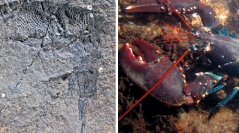

 Geodiversitas
38 (4) - Pages 515-541
Geodiversitas
38 (4) - Pages 515-541Erymid lobsters (Crustacea, Decapoda, Erymidae) are relatively common and abundant in Jurassic rocks (c. 70 species) but are far less common in the Early Cretaceous with about 20 species only listed in Europe, North America, South America, Australia, Antarctic, Japan, and Madagascar. A study of the twelve species of erymid lobsters from the Early Cretaceous of Europe (France, United Kingdom) is here presented. Based on new observations, the concepts of some erymid genera are updated and new diagnoses are proposed for Eryma Meyer, 1840, Enoploclytia M’Coy, 1849, Palaeastacus Bell, 1850, Pustulina Quenstedt, 1857, and Stenodactylina Beurlen, 1928, including carapace groove pattern, first pereiopods and also a new structure – the post-orbital area – located in front of the cephalic region. The new genus Tethysastacus n. gen. is erected with Tethysastacus tithonius n. comb. (Valanginian, France) as type species. Five new species are described: Eryma vocontii n. sp. (Albian, France), Enoploclytia augustobonae n. sp. (Barremian, France), Enoploclytia gigantea n. sp. (Albian, Texas), Pustulina occitana n. sp. (Berriasian, France), and Pustulina colossea n. sp. (Hauterivian, France).
Crustacea, Erymidae, lobster, Mesozoic, Western Europe, lectotypification, new combinations, new genus, new species.